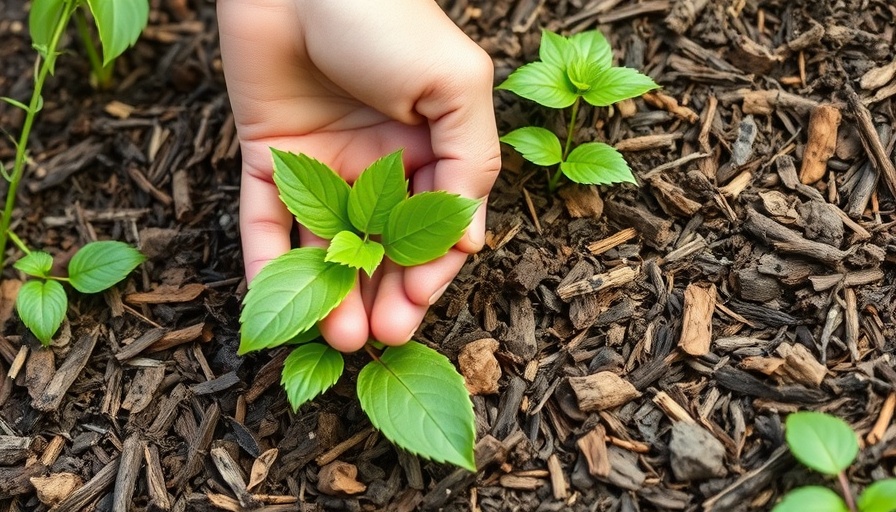
Discover Budget-Friendly Mulch Ideas For Your Garden
Gardening can be a fulfilling experience, especially when it transforms our yards into beautiful landscapes. However, maintaining these spaces can often come with significant costs. For Okanagan gardeners, the challenge of landscaping on a budget can sometimes seem daunting, particularly when it comes to the expense of quality mulch. In our quest for affordable yet effective gardening solutions, we present some creative and inexpensive mulch ideas that not only enhance your garden's aesthetics but also support sustainability and healthy plant growth.
In 'CHEAP Mulch Ideas,' the discussion dives into effective low-cost mulching strategies that have inspired deeper analysis on how to create thriving gardens on a budget.
Why Mulch Matters: The Benefits You Can’t Overlook
Before diving into the budget options, let’s first explore why mulch is beneficial for your garden. Mulch serves multiple purposes: it helps retain soil moisture, suppress weeds, and regulate soil temperature. Moreover, it can add nutrients back into the ground as it decomposes. If you’re unsure about the different types, remember that a good mulch can serve as both a protective layer and a visual enhancer, vital for fostering healthy gardens in the Okanagan climate.
Cheap Mulch Ideas Straight from Nature
One of the best ways to save on mulch is to look around locally for materials. Natural options include grass clippings, fallen leaves, and wood chips. Grass clippings, which some homeowners may discard, can be an excellent source of nitrogen, promoting plant growth. Remember to allow them to dry out a bit before applying them in thick layers to prevent clumping.
Fallen leaves are another underutilized option. Raked leaves, especially when shredded, make for an efficient, biodegradable mulch. This not only recycles organic matter but also provides essential nutrients as they break down. Ask your neighbors if you can collect their leaves, or watch for public leaf collection days in your area.
Wood chips can often be sourced for free from local tree service companies after they complete jobs. Just make sure the chips are fresh, as older, decaying wood may harbor pests or affect your plants negatively.
Repurposing Household Waste as Mulch
Your kitchen and yard waste can also be a goldmine of mulch material! Shredded newspaper or cardboard can create a dense mulch layer that blocks weeds. Just remember to avoid glossy paper, as it can release chemicals into the soil. Instead, mix shredded newspaper with grass clippings or leaves to balance the carbon-to-nitrogen ratio.
Eggshells can contribute to your soil’s calcium levels when crushed and scattered, while coffee grounds can improve soil structure. Both can serve as a lightweight mulch alternative or incorporation into your primary mulch mix.
Budget Products Available for Mulching
If nature doesn't provide enough solutions, consider visiting local garden centers or discount stores for materials. Bark mulch is often sold at reasonable prices, and buying in bulk can save you money in the long run. Look for sales during off-peak seasons, as many retailers will offer discounts at the end of summer or early fall.
Rubber mulch, while slightly more of an investment upfront, lasts longer than wood and reduces maintenance needs. It can be beneficial for areas that experience heavy foot traffic, and its colorful varieties can enhance your garden's visual appeal.
Creating Your Own Mulch: DIY Solutions
If you're feeling adventurous, try making your own mulch! Shredding old wooden pallets or branches can create a rustic, appealing mulch that fits the style of many gardens in the Okanagan. Simply break down the wood into smaller pieces using a chipper or shredder, and scatter or layer it where needed.
Composting is another invaluable tool in your garden toolbox. By recycling kitchen scraps and garden debris, you can produce your nutrient-rich mulch. As you add compost into your flower beds, not only are you enriching the soil, but you also create a layer that helps retain moisture and suppresses weeds, all while being eco-friendly.
Final Thoughts on Sustainable Mulching Practices
Opting for affordable and sustainable mulching practices not only benefits your garden but also supports your local ecosystem. By using repurposed or organic materials, you reduce waste and reliance on commercial products that come with environmental costs.
As we consider the beauty and sustainability of our gardens, it’s evident that there are many ways to approach mulch without breaking the bank.
For greater insights and to share your own gardening stories, consider joining Okanagan gardening groups online. These platforms can offer support, knowledge-sharing, and community connections, enhancing your local gardening experience. By enriching your knowledge on mulching, you can elevate your garden’s health and beauty efficiently. Get started today!
 Add Row
Add Row  Add
Add 




Write A Comment